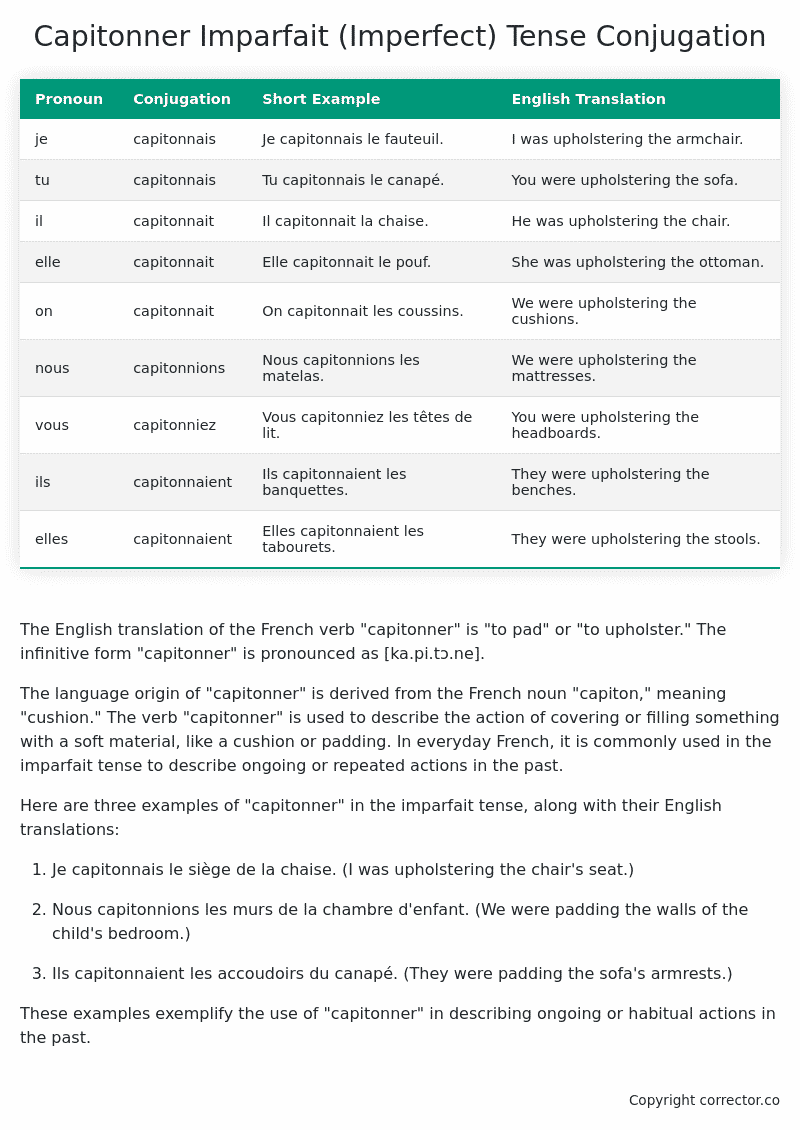Imparfait (Imperfect) Tense Conjugation of the French Verb capitonner
Introduction to the verb capitonner
The English translation of the French verb “capitonner” is “to pad” or “to upholster.” The infinitive form “capitonner” is pronounced as [ka.pi.tɔ.ne].
The language origin of “capitonner” is derived from the French noun “capiton,” meaning “cushion.” The verb “capitonner” is used to describe the action of covering or filling something with a soft material, like a cushion or padding. In everyday French, it is commonly used in the imparfait tense to describe ongoing or repeated actions in the past.
Here are three examples of “capitonner” in the imparfait tense, along with their English translations:
-
Je capitonnais le siège de la chaise.
(I was upholstering the chair’s seat.) -
Nous capitonnions les murs de la chambre d’enfant.
(We were padding the walls of the child’s bedroom.) -
Ils capitonnaient les accoudoirs du canapé.
(They were padding the sofa’s armrests.)
These examples exemplify the use of “capitonner” in describing ongoing or habitual actions in the past.
Table of the Imparfait (Imperfect) Tense Conjugation of capitonner
| Pronoun | Conjugation | Short Example | English Translation |
|---|---|---|---|
| je | capitonnais | Je capitonnais le fauteuil. | I was upholstering the armchair. |
| tu | capitonnais | Tu capitonnais le canapé. | You were upholstering the sofa. |
| il | capitonnait | Il capitonnait la chaise. | He was upholstering the chair. |
| elle | capitonnait | Elle capitonnait le pouf. | She was upholstering the ottoman. |
| on | capitonnait | On capitonnait les coussins. | We were upholstering the cushions. |
| nous | capitonnions | Nous capitonnions les matelas. | We were upholstering the mattresses. |
| vous | capitonniez | Vous capitonniez les têtes de lit. | You were upholstering the headboards. |
| ils | capitonnaient | Ils capitonnaient les banquettes. | They were upholstering the benches. |
| elles | capitonnaient | Elles capitonnaient les tabourets. | They were upholstering the stools. |
Other Conjugations for Capitonner.
Le Present (Present Tense) Conjugation of the French Verb capitonner
Imparfait (Imperfect) Tense Conjugation of the French Verb capitonner (You’re reading it right now!)
Passé Simple (Simple Past) Tense Conjugation of the French Verb capitonner
Passé Composé (Present Perfect) Tense Conjugation of the French Verb capitonner
Futur Simple (Simple Future) Tense Conjugation of the French Verb capitonner
Futur Proche (Near Future) Tense Conjugation of the French Verb capitonner
Plus-que-parfait (Pluperfect) Tense Conjugation of the French Verb capitonner
Passé Antérieur (Past Anterior) Tense Conjugation of the French Verb capitonner
Futur Antérieur (Future Anterior) Tense Conjugation of the French Verb capitonner
Subjonctif Présent (Subjunctive Present) Tense Conjugation of the French Verb capitonner
Subjonctif Passé (Subjunctive Past) Tense Conjugation of the French Verb capitonner
Subjonctif Imparfait (Subjunctive Imperfect) Tense Conjugation of the French Verb capitonner
Subjonctif Plus-que-parfait (Subjunctive Pluperfect) Tense Conjugation of the French Verb capitonner
Conditionnel Présent (Conditional Present) Tense Conjugation of the French Verb capitonner
Conditionnel Passé (Conditional Past) Tense Conjugation of the French Verb capitonner
Conditionnel Passé II (Conditional Past II) Tense Conjugation of the French Verb capitonner
L’impératif Présent (Imperative Present) Tense Conjugation of the French Verb capitonner
L’impératif Passé (Imperative Past) Tense Conjugation of the French Verb capitonner
L’infinitif Présent (Infinitive Present) Tense Conjugation of the French Verb capitonner
L’infinitif Passé (Infinitive Past) Tense Conjugation of the French Verb capitonner
Le Participe Présent (Present Participle) Tense Conjugation of the French Verb capitonner
Le Participe Passé (Past Participle) Tense Conjugation of the French Verb capitonner
Struggling with French verbs or the language in general? Why not use our free French Grammar Checker – no registration required!
Get a FREE Download Study Sheet of this Conjugation 🔥
Simply right click the image below, click “save image” and get your free reference for the capitonner imparfait tense conjugation!

Capitonner – About the French Imparfait Tense
NOTE: To take a deep dive into all the French tenses then see our article on Mastering French Tense Conjugation.
Formation of the Imparfait Tense
For regular -er verbs:
For regular -ir verbs
For regular -re verbs
Common Everyday Usage Patterns
Description of Past Habits
Background Information
Mental and Emotional States
It’s employed to express emotions, thoughts, or physical sensations in the past. For example: “J’étais content quand il est arrivé.” (I was happy when he arrived.)
Ongoing Actions
Points to Note About the Imparfait Tense
Passé Composé vs. Imparfait
Conditional
Si Clauses
Narration
I hope you enjoyed this article on the verb capitonner. Still in a learning mood? Check out another TOTALLY random French verb imparfait conjugation!


